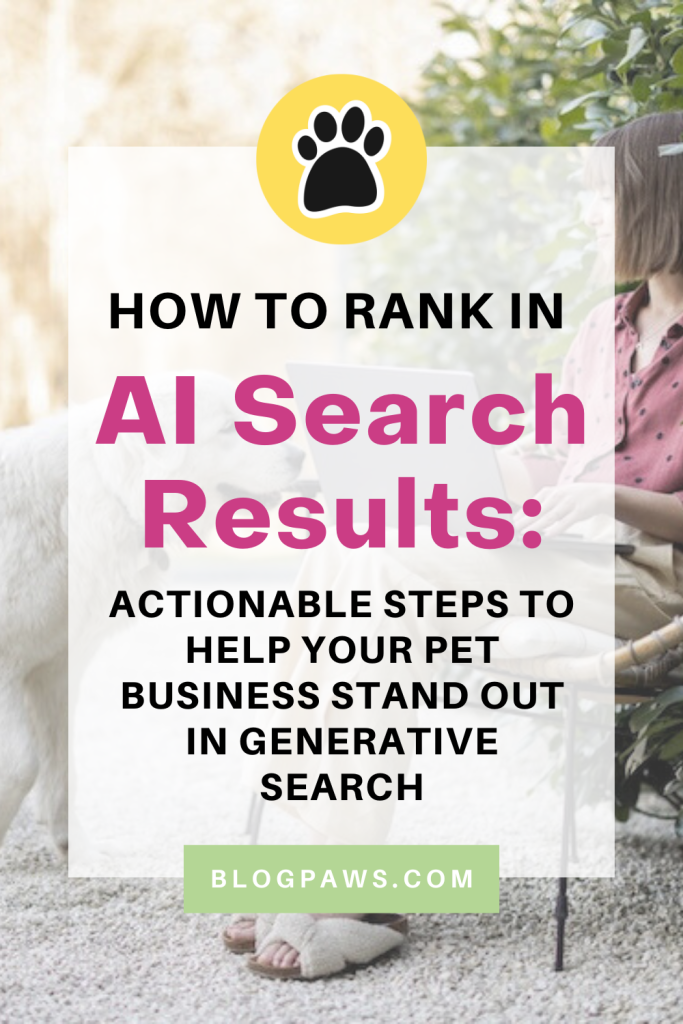How to Rank in AI Search Results: Actionable Steps to Help Your Pet Business Stand Out in Generative Search
We have entered a new world of information seeking, with the average pet parent turning to Alexa or ChatGPT to answer their burning questions. Faced with this reality of AI search, many in the content creation and marketing spaces are frustrated and discouraged.
But the harsh truth is that generative search isn’t going away. Search as we know it has changed, and we need to change with it!
No longer is it enough to simply sprinkle in the “right” keywords to ensure your content will be visible and competitive. Now, we have to consider how to optimize our content for far more intelligent systems powered by AI technology.
Luckily, different doesn’t mean impossible.
Interested in learning how to rank in AI search? In this post, I will share steps you can take to create content that not only resonates with your target audience and positions you as an expert in your niche but also sets you up for success in this new chapter of digital marketing.
Understanding How AI Search Works
Before I start talking about writing AI-friendly content, let’s start with the most basic question. What is AI search, anyway?
Traditional search engines are like a giant library with a very detailed index or card catalogue. You type in keywords for the topic you’re looking for, and the search engine looks up those keywords in its index, showing you a list of web pages where those words appear most prominently. To ensure your content would be shown, you needed to ensure the keywords were present. While the search engine is good at finding keyword matches, it doesn’t actually understand the meaning behind your question.
AI search is like going to the same library, but speaking with a librarian who not only knows the index but also understands more of what you’re really asking. It uses a form of artificial intelligence called Natural Language Processing to process your question and “understand” the meaning and context. You don’t necessarily have to use the perfect keywords; you just have to explain yourself enough for it to seek out data from its index to answer you.
Another term you may hear a lot is Generative Search. This is a more advanced form of AI search where it generates answers by summarizing multiple websites instead of just finding and ranking existing information.
While all generative search is a type of AI search, not all AI search is generative. For example, a search engine that gives you a snippet from a website as an answer before directing you to the site to read further is not “generating” an answer. However, a search like ChatGPT that creates its own answers is considered generative because it’s summarizing mutliple websites in a single cohesive answer (sometimes correct, sometimes incorrect). This difference will be important as you start planning your AI content strategy.
Is AI Search Worth the Effort?
The rise of AI search and generative answers may seem like a threat to content creators and small businesses, and in some ways, it is. But it also offers new opportunities.
Studies have shown that today’s pet parents are no longer just searching for the cheapest, easiest solution for their pets’ care. Instead, they are doing more research than ever before, making well-educated buying decisions and relying on experts to guide their journey in finding the best solution for their needs. If they turn to an AI search engine for information and that search result highlights an expert, it’s like an endorsement that, after reviewing all the different people it has indexed, the search engine has pinpointed that person to be the authority on that topic.
You don’t want that “expert” in your niche to be your competitor – you want it to be you!
By having your website and brand delivered in these AI search results, it is communicating to your target audience that you are a trusted source. This builds brand recognition and trust, helping you grow a community of like-minded pet parents who come to you for advice. It’s not just about chasing clicks, it’s more of a long-term brand building focus.
9 AI Search Optimization Tips
When answering the question “how to rank in AI search,” there is no magical, easy answer. I don’t have a checklist you can work through and know that, if you do everything right, you’re guaranteed to rank the next time someone in your target audience is searching for relevant information in your niche. Trust me, I wish there was, too! However, the process is a little more complex.
Instead, what I can offer are steps you can take to optimize your content, build your overall authority, and increase the chances that you will be seen as that expert.
Don’t Underestimate User Intent
With the focus now on the meaning of your questions versus surface-level keywords, you will need to dig into the “who, what, when, where, why, and how” behind search queries. Why is someone looking for that information? What are they hoping to achieve? When are they planning to use this information, now or in the future?
You can use keyword research tools to explore valuable long-tail keywords and question-based searches to give you more insight into this. For instance, instead of just focusing on a broad term like “cat scratching,” you may find that there are a growing number of people searching “how to stop my cat from scratching furniture” or “best cat trees for small spaces.” Use these insights to create content that will provide them exactly what they are searching for, not a broad overview.
Another great way to understand user intent in your niche is to engage directly with your existing audience. You can use social media polls and Q&A sessions to better understand their specific pain points and the exact solutions they are searching for.
Create High-Quality, Authoritative Content
Now that you know what your ideal audience is searching for, it’s your job as the authority to provide them with the information they need. Create content that doesn’t summarize the basics, but instead provides in-depth, high-quality information that thoroughly addresses the questions you just identified.
Keep in mind that we are in the age of generative engine optimization (GEO) – meaning that the search engine itself will spit out the broad, generic answers without the user ever having to click through to anything further. If all you offer are those easy answers, there is no reason to visit your site or consider what you have to say. Your content will no longer be relevant.
Instead, you want to create content that takes that basic information and then dives deeper for those interested in learning more.
PRO TIP: If you want your content to be considered for AI search results, you must ensure it is being shown where the AI search engines are looking. Many AI platforms, like Copilot and ChatGPT, leverage Bing’s index. Getting your website indexed on Bing is relatively simple (we have a guide to Bing Webmaster Tools you can follow), and it ensures you are at least in the game.
Bring Something New to the Table
Another way to increase the chances of your content being shown instead of every other blogger or business in your niche is to introduce something new into the conversation. What do I mean by that? For years, blog posts were created by sharing the same generic information, rewritten. For example, if someone were a blogger in the dog enrichment space, they may share a blog post with reasons for introducing a snuffle mat, but those reasons are often the same as those given by many others in the space.
Now you may be thinking, okay, but there are only so many benefits to give! It’s not like I want to list 200 reasons a snuffle mat is worth consideration. True! It’s not always about just adding to that number. Instead, consider creative ways you can add value.
You could poll your audience to create new data, giving insights into the use of snuffle mats with dogs. You could do a hands-on comparison of multiple snuffle mats, including photos and/or videos, providing an in-depth breakdown that goes beyond the current product reviews. You could leverage an expert like a dog behaviorist to dig into why dogs prefer some snuffle mats over others.
If your content only delivers the same information everyone else has already provided, you risk being lost in the weeds. To earn a mention in AI search results, you must offer value that no one else has.
Optimize for Natural Language
Keyword stuffing was never the best approach (spam, anyone?), but it worked with traditional search engines to a degree. Why? Because it puts the specific keywords forward in a way that the web crawlers would pick them up and index them. But times have changed. When writing AI-friendly content, your relevant keywords and phrases should flow naturally.
Consider how people are actually speaking and typing their search queries. What would they say if someone were talking to Alexa and asking for information about your niche? These are the phrases that should create the foundation of your content strategy. From there, you can add relevant keywords to support your greater SEO efforts.
For example, if you are writing a blog post about housetraining a puppy, you should consider using conversational phrases like:
- How do I potty train my puppy?
- What’s the best way to housebreak a puppy?
- What’s the easiest way to house train a puppy?
- Why does my puppy keep having accidents inside?
- Potty training schedule for an 8-week-old puppy
Then, you can add topical keywords to support the topic, such as:
- Housebreaking puppy
- Dog potty training
- New puppy training
- Puppy house training
The goal is to write content that speaks to people where they are at. Your content should have a conversation with your audience, answering their questions and connecting with them on their level.
Leverage Schema
We’re going to get a little more technical for this one, but I will try to break it down in a way anyone can understand… Schema markup is like a hidden code on your website that helps search engines better understand the meaning and context of your content. It helps to highlight specific information to show its relevance for a search.
For example, “HowTo” schema ensures that these search engines know they are getting a step-by-step guide, while “Product” schema promises that the content will deliver key product details.
Returning to the library analogy above, the schema is like the categorization – you have a self-help section, a fantasy section, etc. By organizing a book into the right category, you make it easier for everyone to know what it’s going to be about. Similarly, by including these schemas in the relevant places on your website, you can optimize your blog for AI search in a way that their systems better understand the context of your content.
Incorporating this code on your website is easier than it sounds. Many modern SEO tools like Yoast SEO and RankMath offer schema controls, putting the correct code in the right places with a bit of basic setup in their dashboard.
If you aren’t on WordPress (both those tools are), prefer a more hands-on technical approach, or simply want to learn more about the concept of schema and how it’s used, you can use an online schema generator like the one offered by Rank Ranger and the Google Schema Markup Testing Tool to set up and verify your schema manually.
Built Topical Authority
To establish yourself as the go-to source of knowledge and information in your niche, you will need to build topical authority on your website.
Consider this: You’re looking for a dog trainer to help you address a behavioral issue with your dog. Who would you trust more – the trainer with a wide collection of articles breaking down different training techniques, behavioral considerations, and training tools, or the trainer whose website only has a single post or two about dog training? The trainer who has demonstrated a broader knowledge of their niche is leveraging topical authority.
To do this, you will need to create a cluster of interconnected content around the core topics, or content clusters, that are most important for your blogging niche or business. This signals to AI that you are knowledgeable about all aspects of your chosen niche or industry.
This isn’t just about creating the content; it’s about how you link it together. Strategically link relevant blog posts internally to reinforce their connection and your authority on the subject. In addition to helping AI better understand your website, it will also offer a clear journey for any visitors to your site to find more information about a topic.
For example, if you have a blog about senior cat care, you may have an overall guide to grooming a senior cat, as well as more targeted blog posts about senior cat dental care, trimming a senior cat’s nails, cleaning a senior cat’s ears, etc. This content should all be connected through internal linking to create a cluster of information for someone looking to groom their aging cat.
These content clusters are also the topics you are going to be known for, so choose them wisely.
If sorting your content into a few buckets, or clusters, is too challenging, it may be a sign that your current focus is too broad, and it’s time to niche down. At a time when being “the expert” is the key to success, trying to specialize in everything can water down your authority and prevent you from being seen as the expert in anything.
PRO TIP: Take a moment to go back through your existing published content to identify opportunities to link to your newer content. Many successful bloggers will set a calendar reminder to do this once a quarter.
Focus on EEAT (Experience, Expertise, Authoritativeness, and Trustworthiness)
We have all heard the buzz about EEAT as it pertains to Google and the ever-changing Google search results. But you may not realize that demonstrating EEAT on your website is also key to ranking in AI search.
Showcasing your expertise helps to set you apart from your competitors, giving search engines a reason to prioritize the information you’re sharing over everyone else. You can do this by sharing your own first-hand experiences and credentials in clear and easy-to-spot places, like in your author bio on each blog post and your “About” page.
You can also leverage someone else’s expertise by including quotes and opinions from those recognized as the authority on a specific topic, like a veterinarian when referencing medical topics.
Ensure your website is trustworthy by always providing accurate, up-to-date information and citing credible sources when necessary. This means updating your content periodically to ensure it’s not becoming outdated. Additionally, you should ensure that your website includes the required pages, like a privacy policy and a contact page, to make it easy to reach out to you if there are concerns.
Consider Content Formatting
The way you structure your content not only makes it easier for the reader but also makes it easier for AI algorithms to understand and index the information you’re providing. Use clear headings, subheadings, bullet points, and numbered lists to make it easy to digest.
A table of contents is a great way to help your audience navigate longer content while creating a quick and easy-to-find overview of what the content will answer when your content is being crawled and indexed. Of course, for this to work effectively, you must choose headings that accurately describe what you will be talking about.
Tables are a great way to organize information in a way that’s easy for everyone to understand, including humans and AI algorithms. Use clear and descriptive headers to ensure that there is no confusion about what is being shown.
Optimize Visual Content
Finally, don’t overlook the power of visuals. While there is a lot of debate right now surrounding AI-generated images, that’s not the only time that visuals are considered in AI search. Depending on the search term, visuals may be delivered to support the search intent, but only if the AI algorithm can understand the visual content you share.
Use descriptive file names and alt text for all images and videos, clearly highlighting what the content depicts and incorporating relevant keywords where they fit naturally. For videos, ensure accurate transcripts and closed captions are available.
You may want to consider creating short, informative video snippets that directly address common questions in your niche, as these can be easily understood and potentially featured in AI-generated responses. At the same time, these short snippets can also be used to support your Instagram Reels, TikTok, and YouTube Shorts efforts.
Images that perform well in AI search include:
- Original product photography
- Original location photography
- Infographics
- How-to illustrations and diagrams
- Before-and-after images
- Visual comparison charts
Many of these graphic additions can be made easily in programs like Canva using the templates they have available.
Embrace the AI-Powered Future of Content Marketing
The emergence of AI search marks a significant change in the way we approach content marketing, but it doesn’t have to be all doom and gloom. By embracing these tips, you can start to view generative engine optimization not as a hurdle but as an opportunity to connect with your audience in more authentic and meaningful ways.
The future of content, especially in the pet space, is intelligent, high-quality, valuable, and user-focused. By prioritizing these elements in your content creation, you’re not only learning how to rank in AI search, you’re also solidifying your role as a trusted resource and expert in your niche. It’s a win/win. So, what are you waiting for?
Are you currently leveraging the power of AI search as a user? If so, how has it changed the way you view it as a content creator or small business owner? We’d love to hear your thoughts in the comments!
About the Author: Britt Kascjak, BlogPaws Director of Content & SEO, is an award-winning freelance writer whose background in digital and social media marketing spans 15+ years. She’s been a content creator in the pet industry for 9+ years with her own blogs: Shed Happens, The Kas Pack, and Lucifer the Rescue Pup where she shares her life and outdoor adventures with her 2 dogs and 3 cats. Read more…






